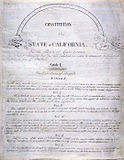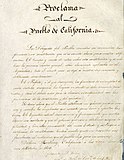
Back Конституция на Калифорния Bulgarian Constitución de California Spanish Constitution de la Californie French 캘리포니아 헌법 Korean Grondwet van Californië Dutch Конституция Калифорнии Russian Kaliforniya Anayasası Turkish Конституція штату Каліфорнія Ukrainian 加利福尼亞州憲法 Chinese
| Constitution of the State of California Constitución del Estado de California (Spanish) | |
|---|---|
|
Title pages of the original English (left) and Spanish (right) versions of the 1849 Constitution | |
| Overview | |
| Jurisdiction | State of California |
| Subordinate to | Supreme law of the United States |
| Created | 13 October 1849 |
| Ratified | 7 May 1879 |
| History | |
| Amendments | 514 |
| Location | California Capitol Museum, Sacramento, California |
| Author(s) | Monterey Convention of 1849 |
| Signatories | 48 delegates |
 |
|---|
The Constitution of California (Spanish: Constitución de California) is the primary organizing law for the U.S. state of California, describing the duties, powers, structures and functions of the government of California. California's constitution was drafted in both English and Spanish by American pioneers, European settlers, and Californios (Hispanics of California) and adopted at the 1849 Constitutional Convention of Monterey, following the American Conquest of California and the Mexican–American War and in advance of California's Admission to the Union in 1850.[1] The constitution was amended and ratified on 7 May 1879, following the Sacramento Convention of 1878–79.[2]
The Constitution of California is one of the longest collections of laws in the world,[3] mostly due to provisions enacted during the Progressive Era limiting the powers of elected officials, but largely due to additions by California ballot proposition and voter initiatives, which take the form of constitutional amendments. Constitutional amendments may be proposed by the California Legislature or by popular petition through the exercise of the initiative power by the voters, giving California one of the most flexible legal systems in the world. It is currently the eighth longest constitution in the world.[4]
Many of the individual rights clauses in the state constitution have been construed as protecting rights even broader than the United States Bill of Rights in the Federal Constitution. An example is the case of Pruneyard Shopping Center v. Robins, in which "free speech" rights beyond those addressed by the First Amendment to the United States Constitution were found in the California Constitution by the California courts.[5] One of California's most significant prohibitions is against "cruel or unusual punishment," a stronger prohibition than the U.S. Constitution's Eighth Amendment prohibition against "cruel and unusual punishment."
- ^ "California Secretary of State -1849 California Constitution Fact Sheet". Archived from the original on November 9, 2017. Retrieved May 1, 2018.
- ^ 1879 California constitution. Retrieved January 3, 2018.
- ^ Janiskee, Brian; Ken Masugi (July 27, 2007). "2". Democracy in California: Politics and Government in the Golden State (2 ed.). Rowman & Littlefield Publishers, Inc. p. 27. ISBN 978-0-7425-4836-7.
- ^ "California's Constitution is Not the Longest". SCOCAblog.com. SCOCAblog. June 24, 2017. Retrieved October 2, 2017.
- ^ Linda Greenhouse, "Petitioning Upheld at Shopping Malls: High Court Says States May Order Access to Back Free Speech," The New York Times, 10 June 1980, A1.
© MMXXIII Rich X Search. We shall prevail. All rights reserved. Rich X Search

